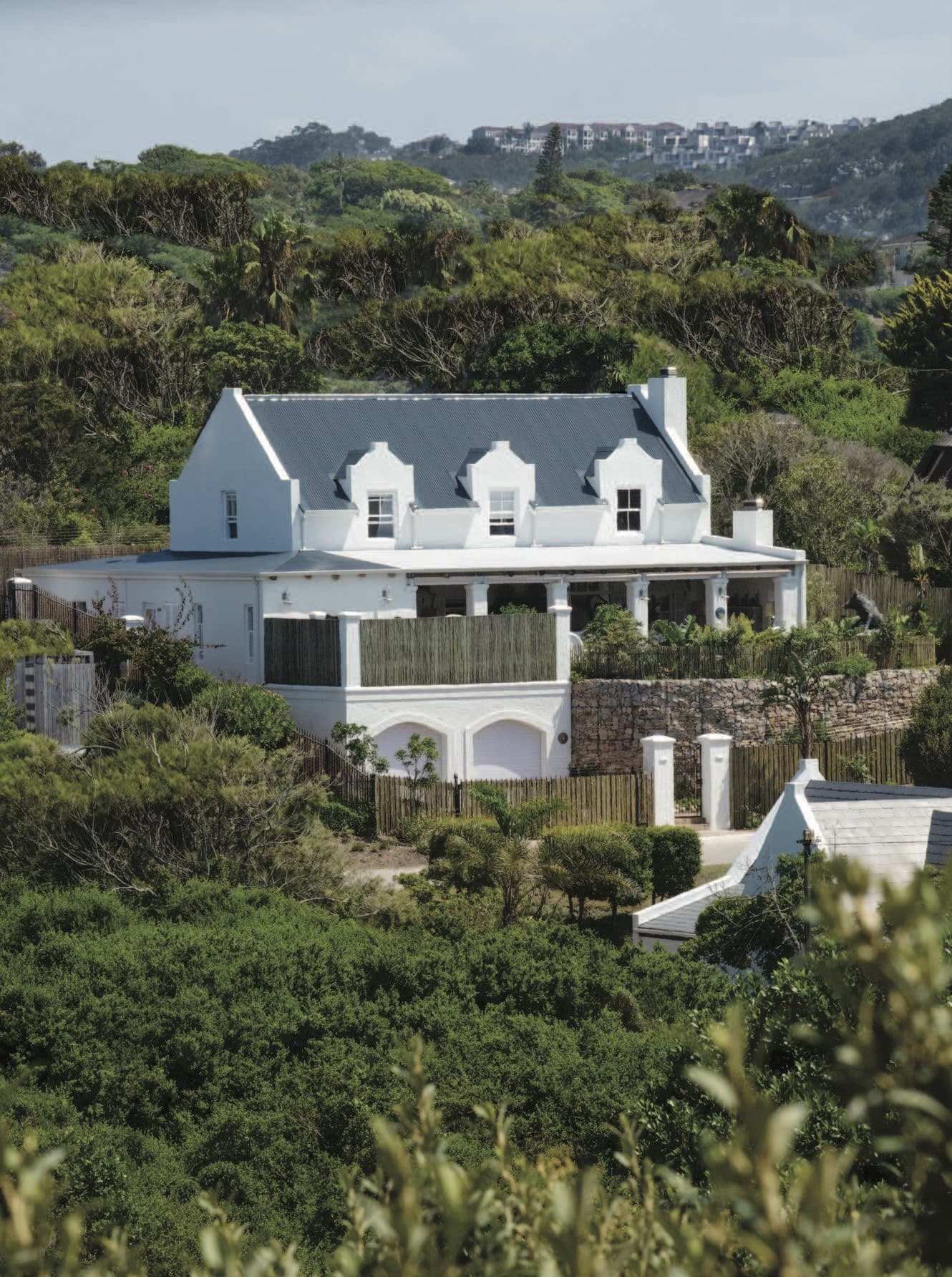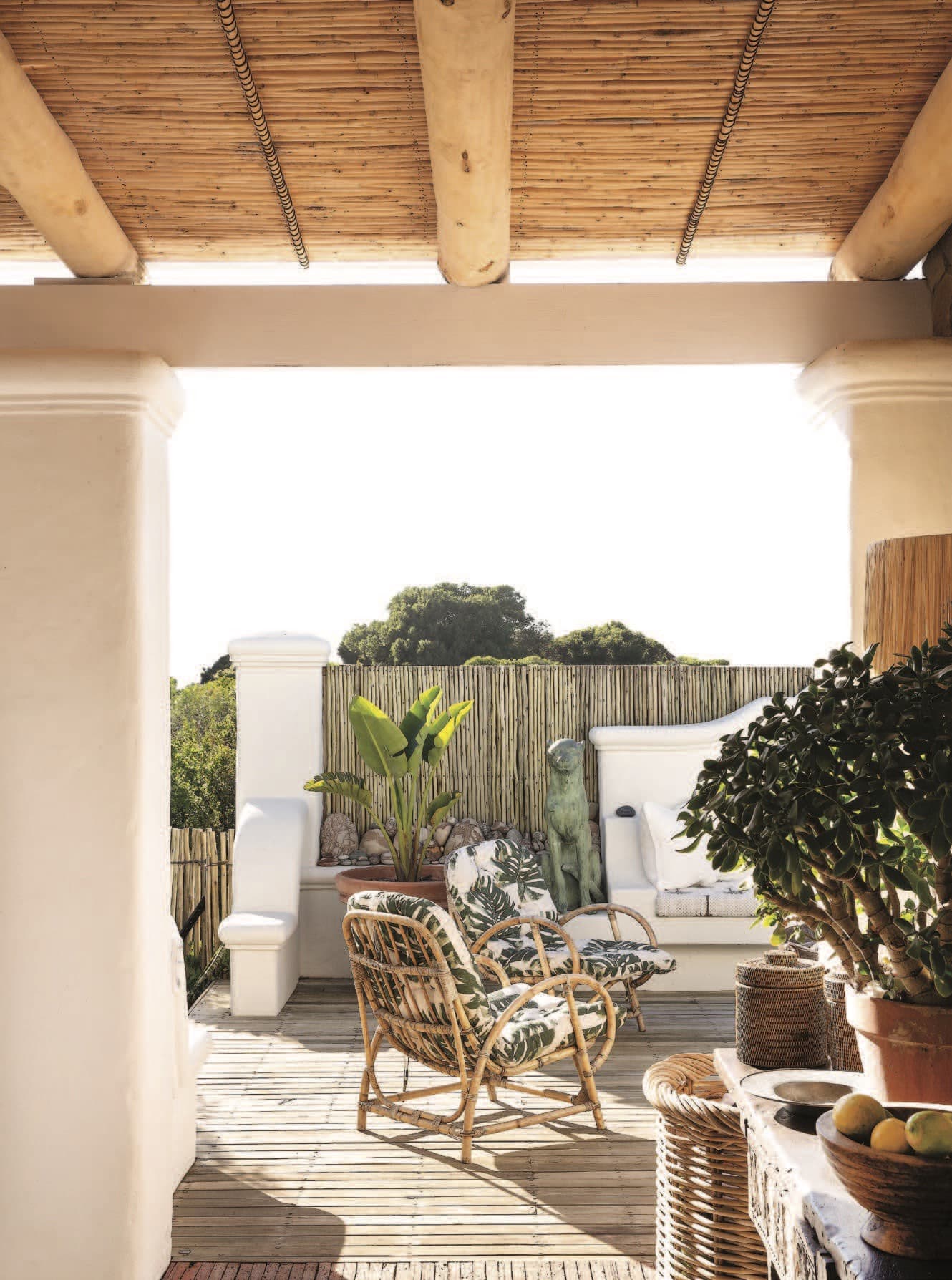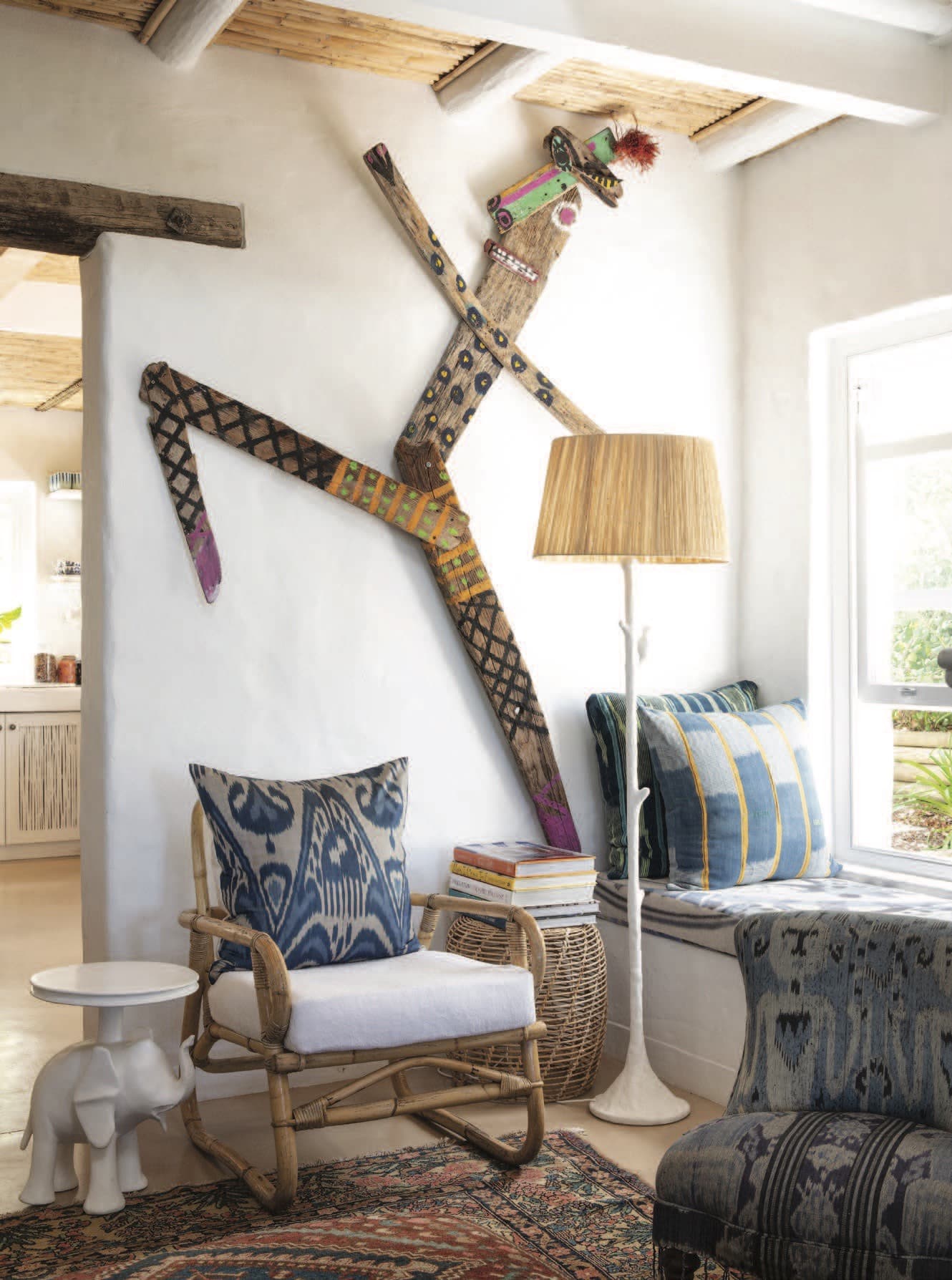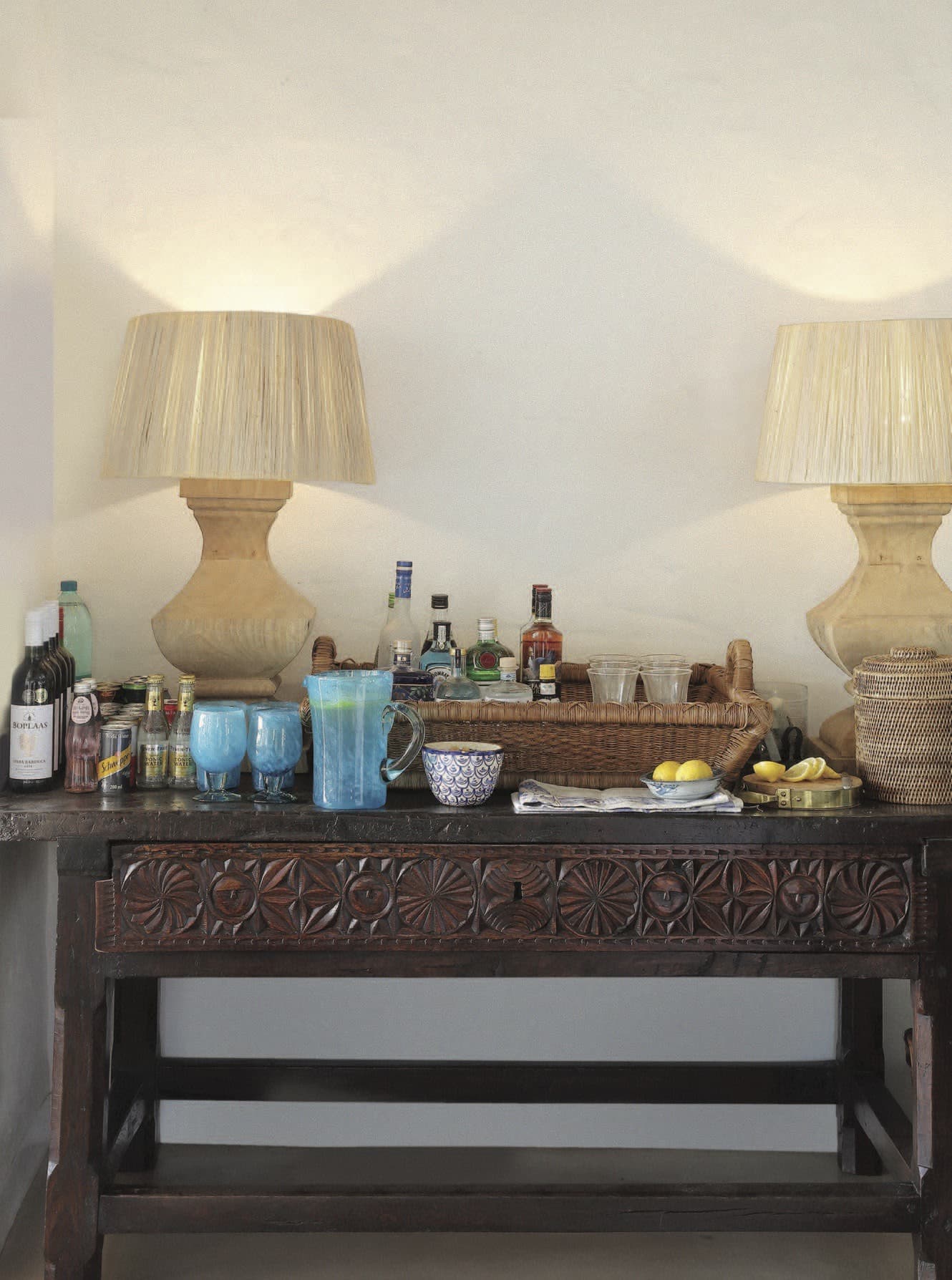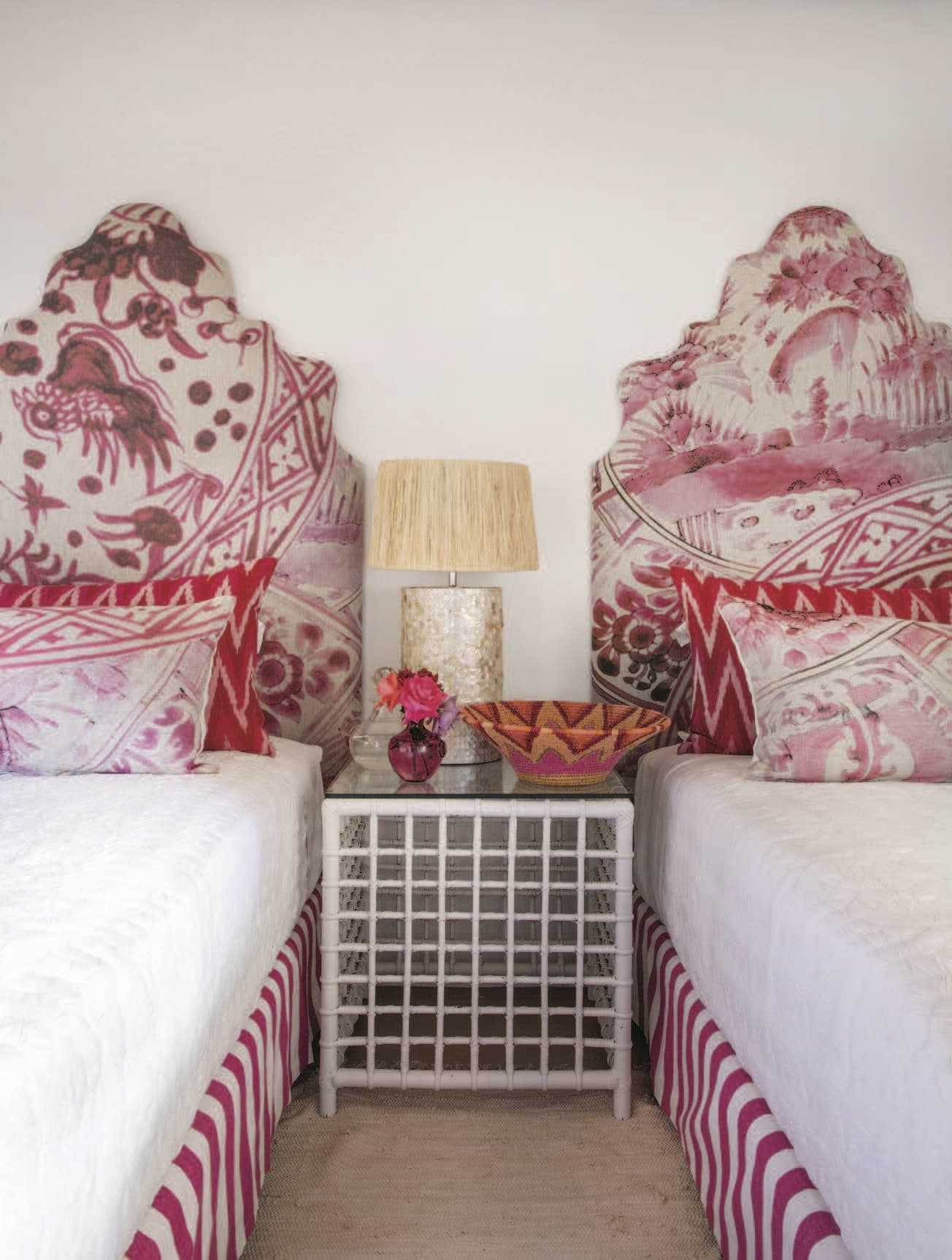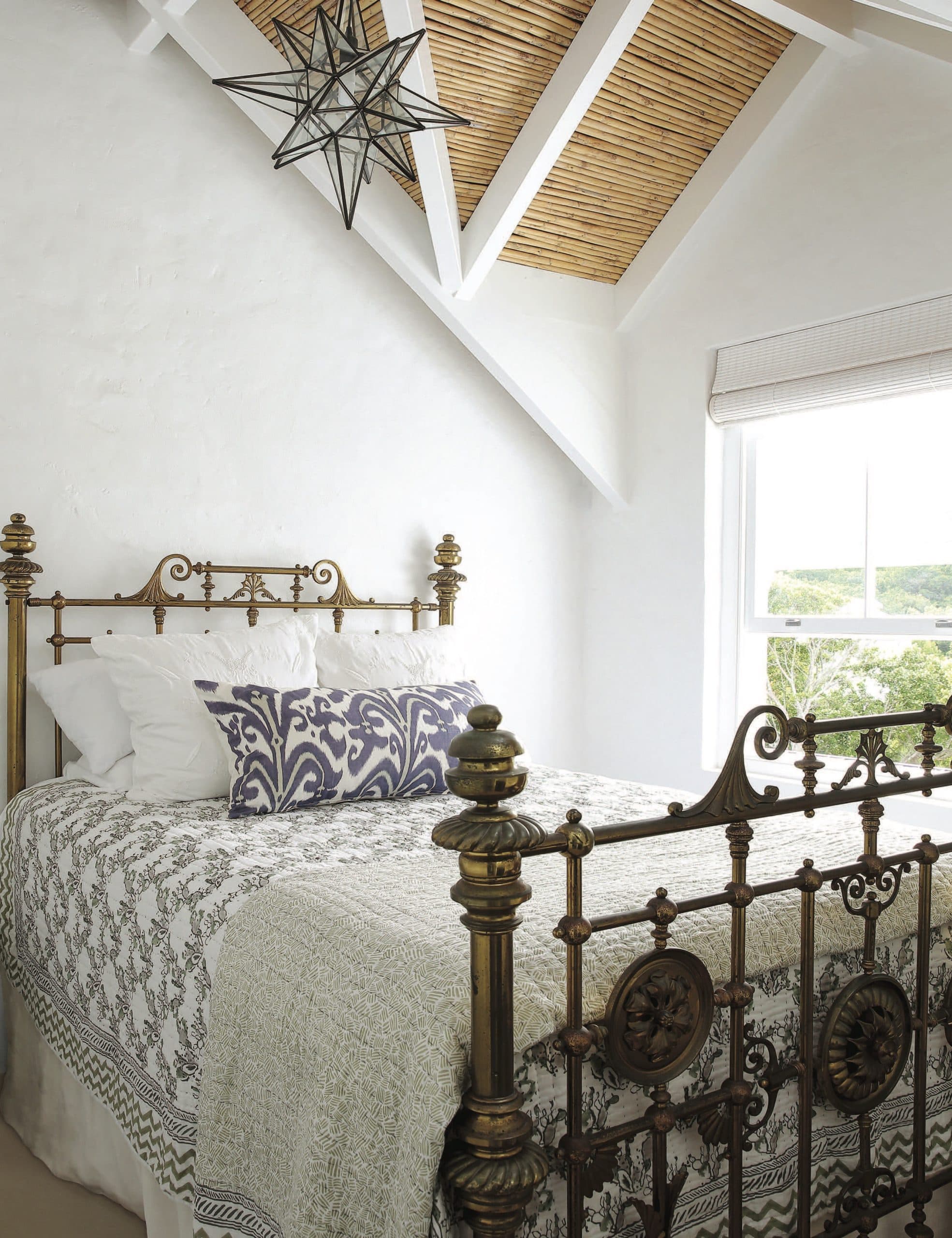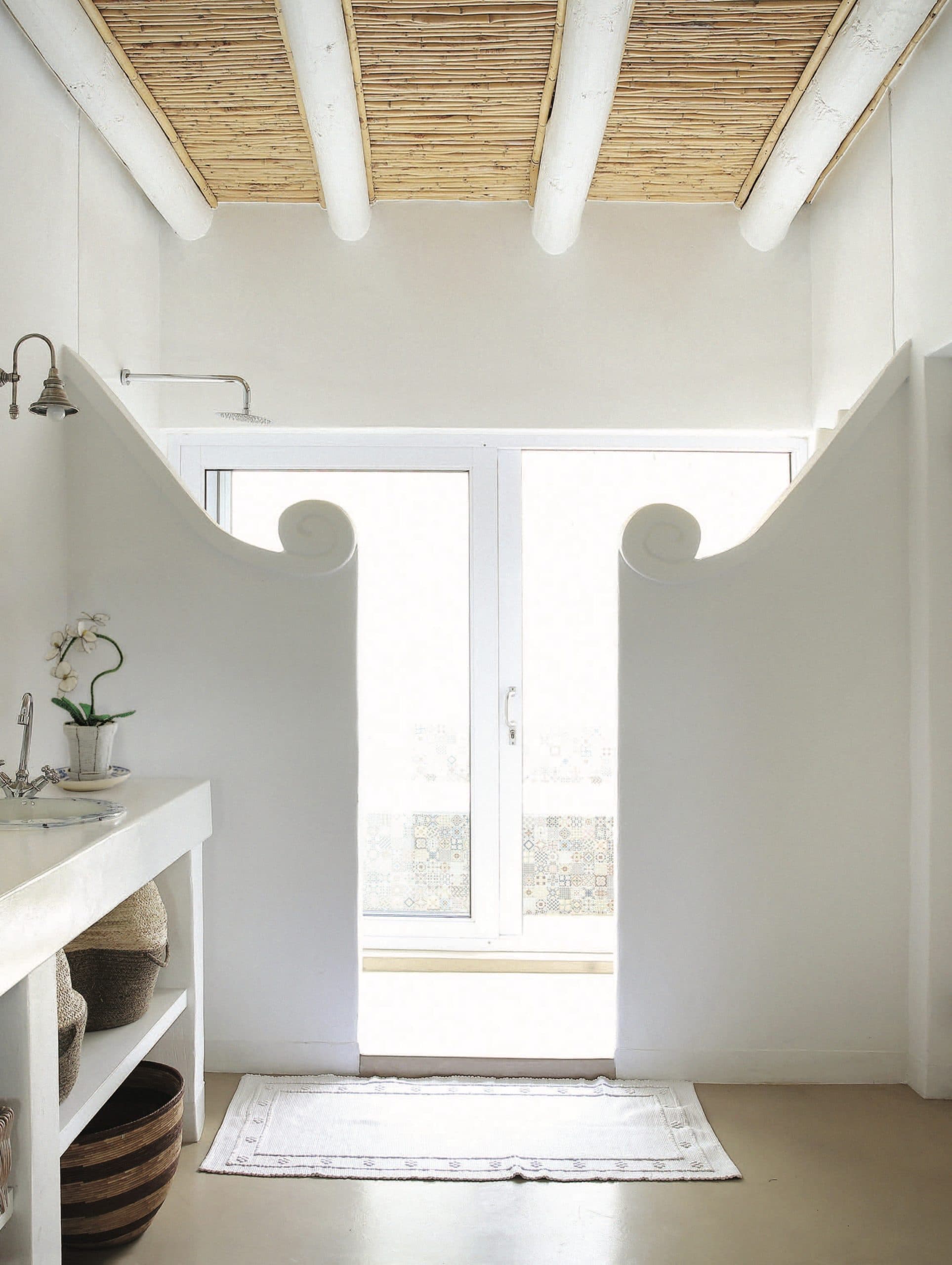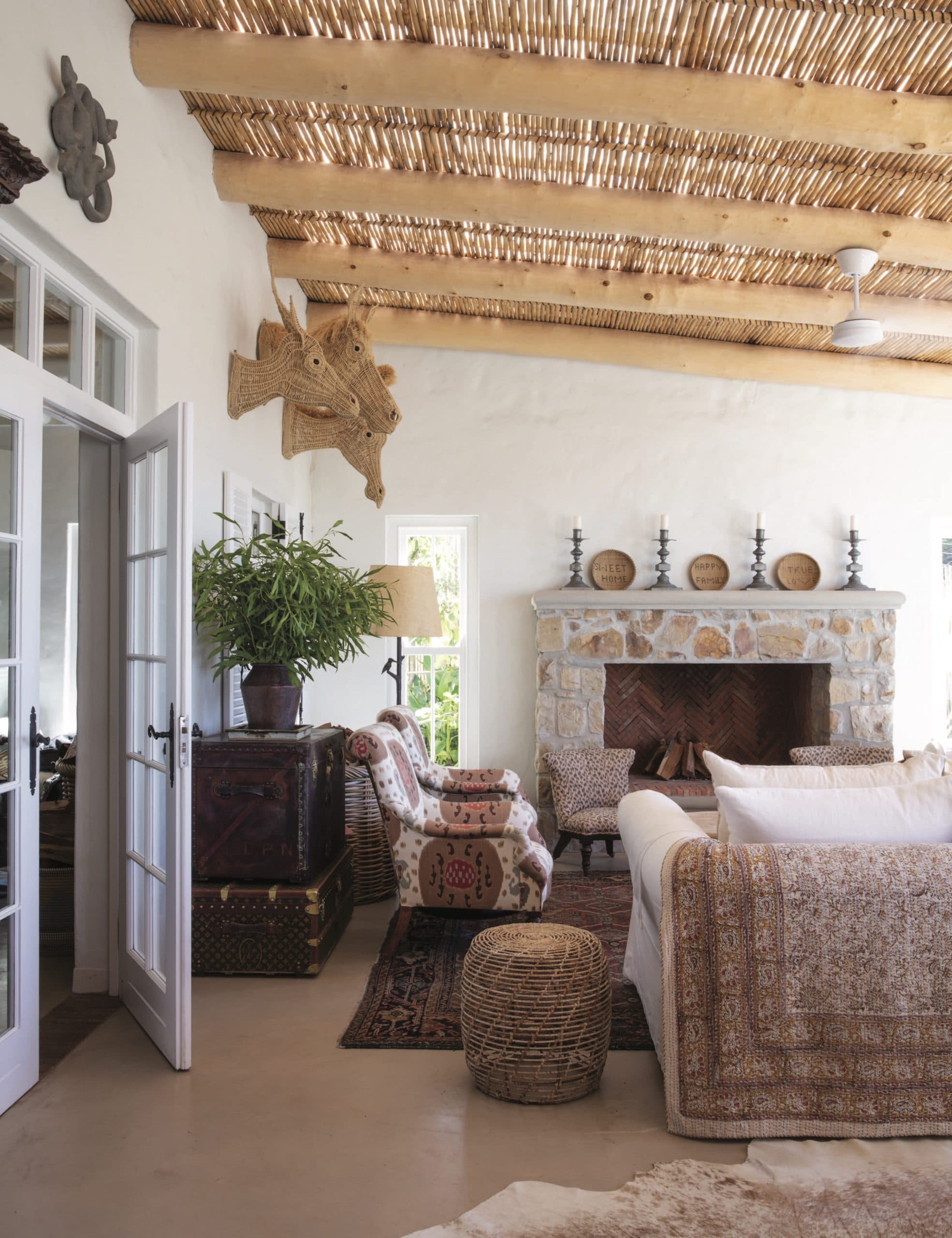
After a lifetime of living all over the world, interior designer Serena Crawford and her husband, Murray, were ready to return to Plettenberg Bay on South Africa’s southern coast and their soul-filled cottage, which they have named Lalapanzi. Both Murray and Serena had enjoyed idyllic childhood vacations on Plett’s beaches and reuniting with the same friends each summer, many of whom still have second homes in town. Later, married and with two daughters, the couple split their time between a cliff-top stone castle here and an elegant house in Sydney. Forty years on, Serena is happily at home in a beach house of relatively humble proportions that, she explains, is filled with the emotional resonance that can only be found in the beauty of the handmade and the sense of place that comes from being surrounded by the comfortingly familiar.

The ceiling of the veranda is made of poplar and cane, in a style of construction traditional to the Eastern Cape. Baskets from Botswana, which Crawford bought from vendors by the side of the road, sit atop an antique Portuguese armoire that has been repurposed as a drinks cabinet. To the left is a Louis Vuitton trunk. The table in the foreground is originally from a monastery in Seville.Henrique Wilding
The house is surrounded by fynbos, the vegetation typical of this part of South Africa.David Oliver
Botanical printed fabric and a traditional Cape Dutch bench can be found on a terrace.Karl Rogers/Vignette
In pursuing a big life, by which she means one that is experiential and full of spontaneous adventures and deep learning, Serena realized that running big, perfectly kept homes was robbing her of that precious commodity—time. It was for this reason that she decided not only on Plettenberg Bay—a homecoming—but on downsizing and simplifying everything about her life.
She invited her London-based daughters (one an artist, the other working in philanthropy) to choose whatever they wanted, from art to antiques, vintage clothing to books, and got rid of everything that wasn’t destined for either the South Africa cottage or her London apartment. (The London pied-a-terre will eventually be filled with a careful edit of precious things that have no place at the beach.) The letting go of “stuff” has been liberating, says Serena, who has loved every minute of it.
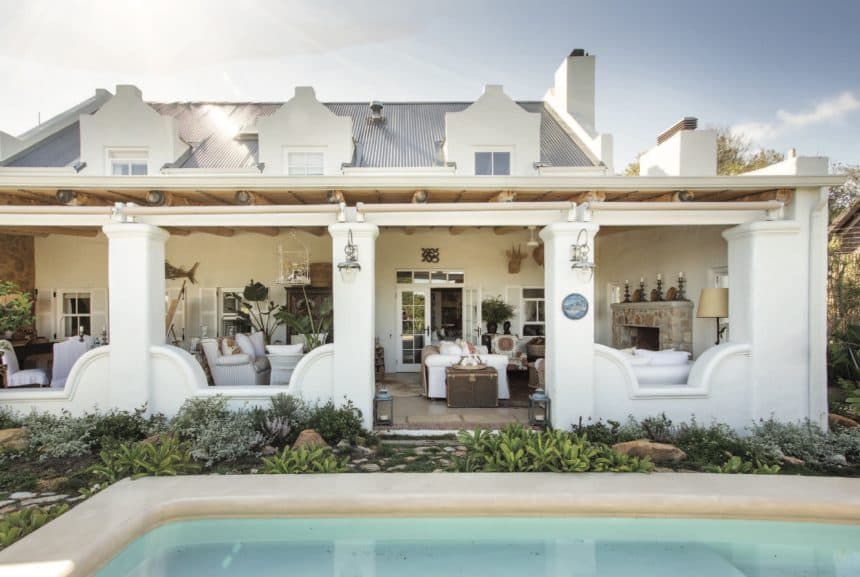
A view of the pool and veranda.David Oliver
The rietdak (or reed roof) ceiling uses bamboo grown in Oudtshoorn, near Plettenburg Bay.Courtesy of Serena Crawford
The Crawfords reduced their collection of books by half to fit it into their mezzanine library.Henrique Wilding
Some of the pieces that survived this ruthless cull include original vintage Vuitton trunks, irreplaceable antique fabrics and pieces of furniture with special provenances— often acquired on her travels. There’s the somber dining table with the frivolous twirled legs found in a Seville monastery, and the workhouse of a kitchen table with yellowwood legs that came with the castle they used to own. Then there’s the intricately carved Portuguese armoire that serves as a drinks cabinet. “It’s been in every single house we’ve ever lived in,” says Serena, who believes that a house feels immediately like home with a few well-chosen familiar pieces. “Our dining tables have had the same elbows resting on them for decades! This is especially comforting to my daughters when they visit us.”
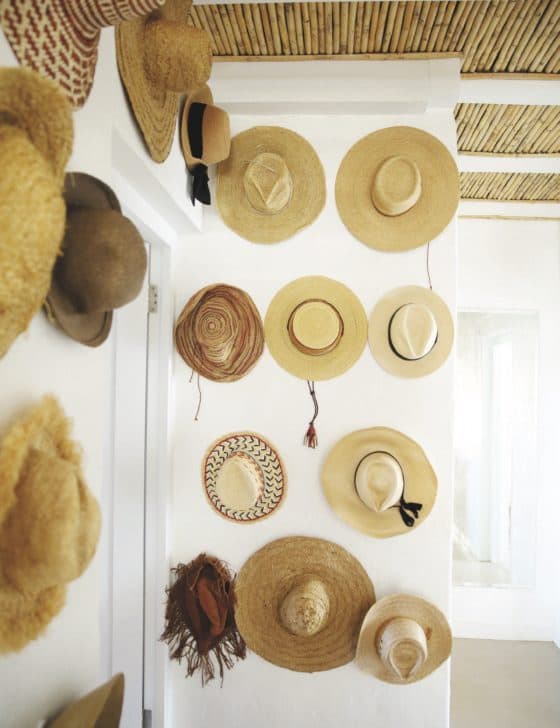
Crawford purchases hats on all of her travels and her collection includes ones from Australia, Ghana, Italy, Mozambique and Zimbabwe.Henrique Wilding
Serena has been scouring markets, auction houses and “the side of the road” for treasures all her life. She buys a hat wherever she travels and has never been able to resist interesting textiles. For someone who loves collecting, including blue-and- white porcelain—a collection that started 40 years ago with a trio of Persian ginger jars bought on auction at Christie’s in London— keeping the interiors relatively empty took discipline. “A white house, especially if it’s a beach house, needs very little,” she says.
The original cottage was no beauty, but Serena was attracted to the thick, whitewashed walls typical of Cape vernacular architecture, its proximity to the ocean and the surrounding bird-filled indigenous bush, or fynbos. One of the cottage’s most interesting features was a thatched roof, which Murray immediately declared a fire hazard and instructed the builders to dismantle. Its removal became a catalyst for change, however, providing the opportunity to raise the walls and add a triple-volume gallery that houses a much-loved book collection (Africana, biographies, interiors, gardening, inspirational literature) above a central living room dominated by an enormous fireplace. Leading off it is a new veranda where Serena sometimes sleeps in summer so that she can look at the stars.
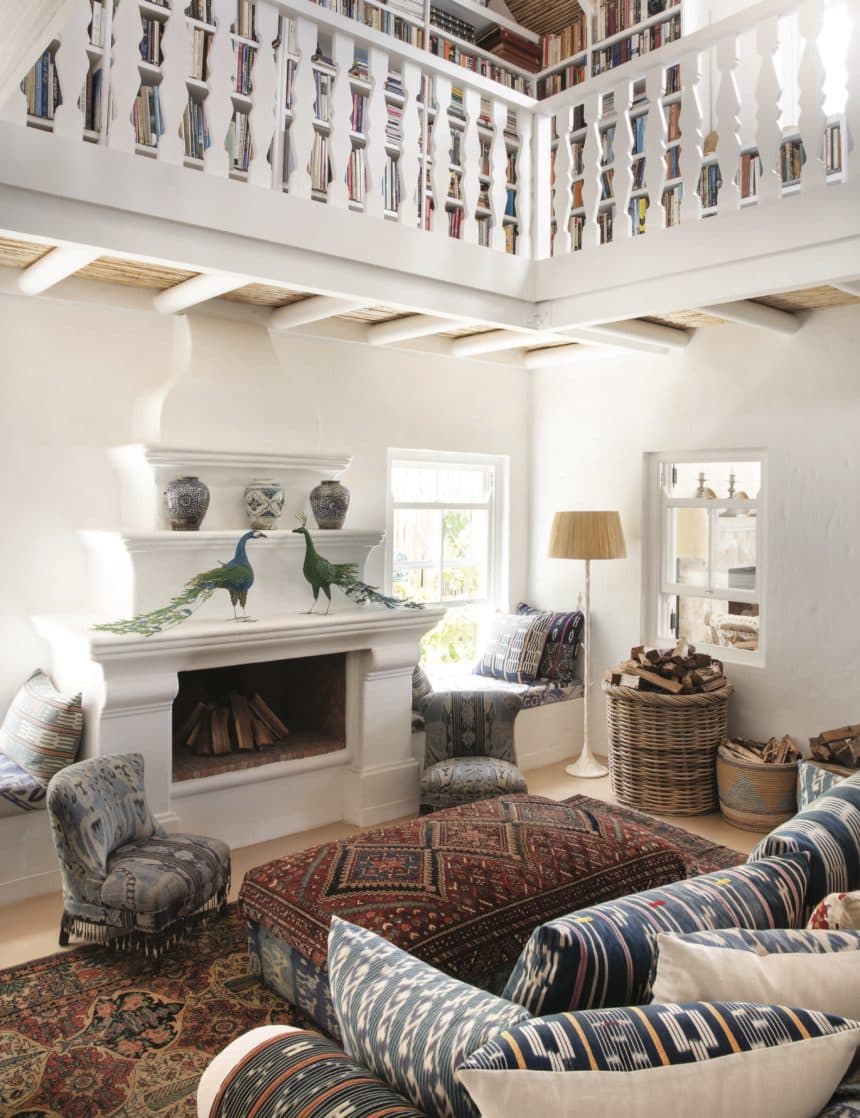
After purchasing the home, the Crawfords removed its thatched roof and added a mezzanine-level library above the living room. The three-tiered fireplace is based on a design typical of Corfu.Karl Rogers/Vignette
A sculpture by Beezy Bailey is of Crawford dancing.Henrique Wilding
A 17th-century oak sideboard serves as a bar.Karl Rogers/Vignette
“The way to begin visualizing a perfect room is to take pencil to paper. A house designed with hand sketches, rather than on a computer, immediately has emotional resonance,” explains Serena. She acknowledges that this is an expensive and time consuming way to build. In the end, dozens of last-minute changes later, the result is a more interesting and original design. She is committed to supporting artisans, especially those keeping age-old techniques alive. “The men who helped build this house have become my artists—all the artisans of this world are my artists,” she says.
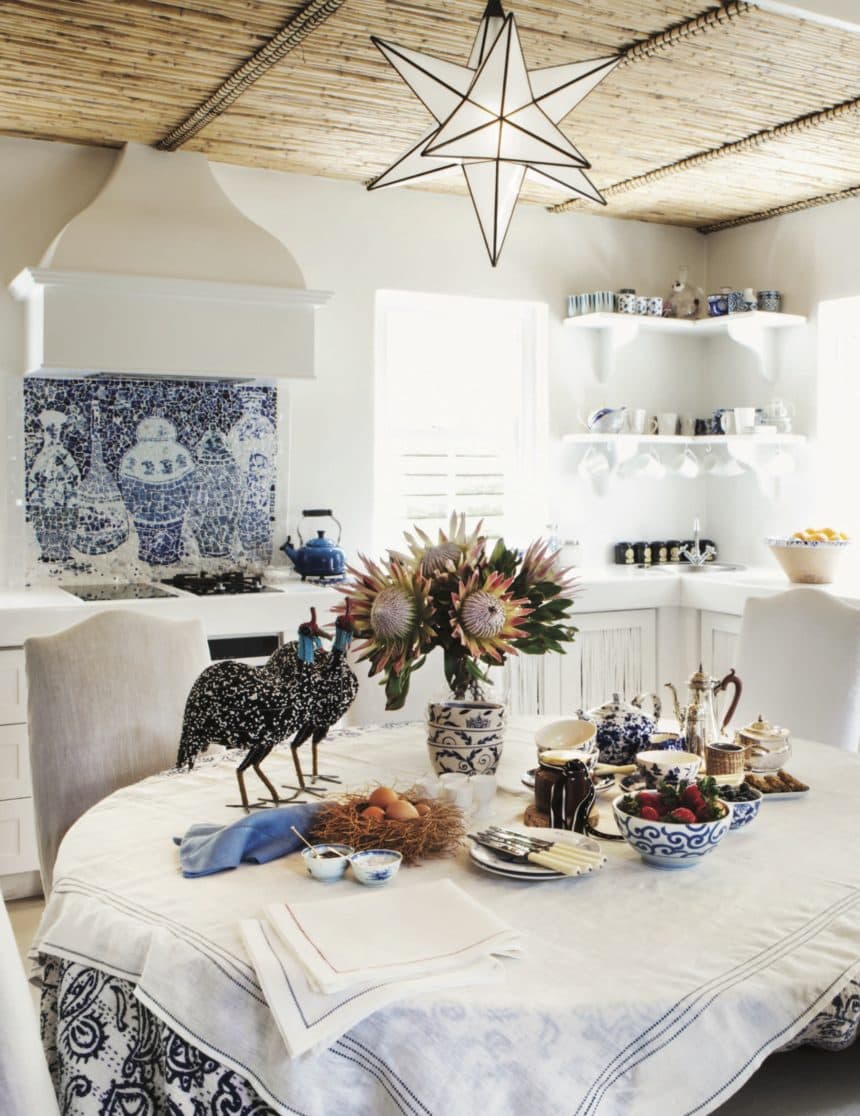
The kitchen’s backsplash was inspired by three Persian ginger jars that Crawford bought at auction; it uses broken pieces of blue-and-white crockery, including ones that date to Portuguese settlers. Guinea fowl are common in Plettenberg Bay; these beaded ones were made by a Zimbabwean artist.Vanessa Brewer (AVO Photography)
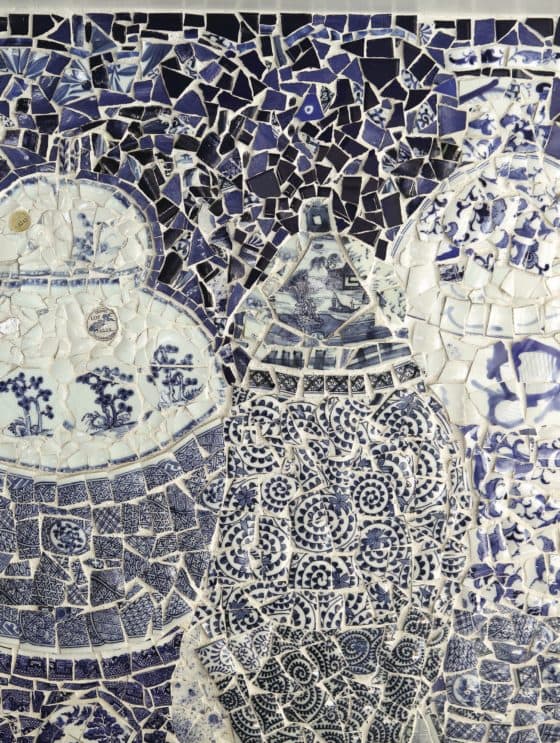
The human hand is evident in every detail. From the plastered walls, cement floors and exposed beams hewn from Eastern Cape poplar, to the traditional reed ceilings and bamboo cupboard doors secured with twine, everything was specially commissioned and created by hand. There is a perfection in the slight imperfections that naturally exist in hand-shaped surfaces, palpable to the touch but not visible in a photograph.
The three ginger jars were the inspiration for a striking mosaic backsplash commissioned for the kitchen. It was pieced together from broken blue-and-white crockery Serena could never bear to throw away, as well as shards of antique porcelain found in the vineyards of the Constantia Valley when they lived there.
The house has five bedrooms, romantically done up in antique linen and cool Indian cottons. Two of them have private, outdoor baths—Serena encourages her guests to follow her habit of bathing alfresco throughout the year, even in winter.
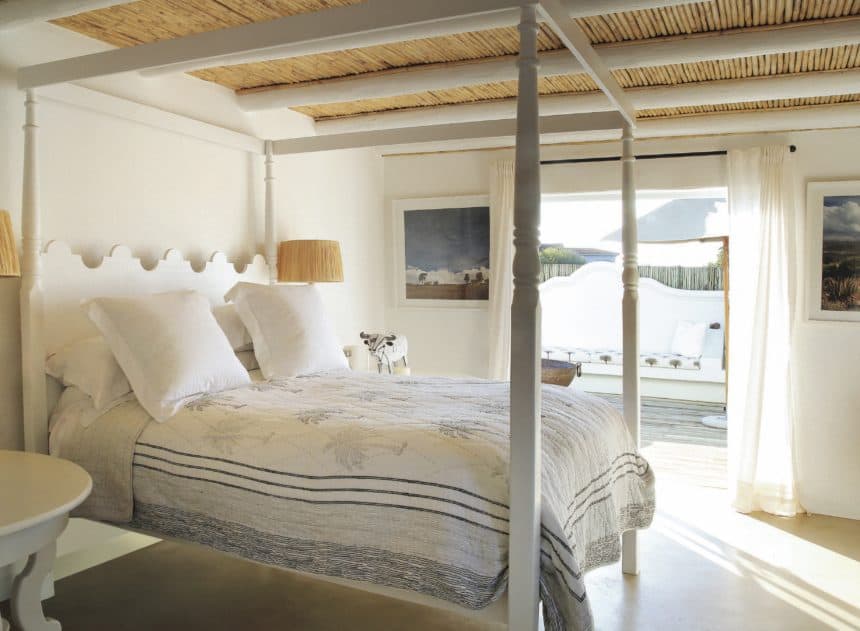
The four-poster bed in a guest room was inspired by one in Veere Grenney’s Tangier home.Henrique Wilding
The red and pink fabrics in another guest bedroom reference Asian porcelains.Karl Rogers/Vignette
A 19th-century bed sits underneath one of the star-shaped lanterns that Crawford uses in many rooms.Henrique Wilding
“I’ve come to realize that all I actually need are an extremely comfortable bed and the most comfy, generous sofa, because that’s where I live whether socializing or resting. Otherwise, you’ll find me outdoors!” Hiking, outdoor swimming and meditation add rich layers to her new life.
Her greatest joy, however, is to be lulled to sleep by the sound of the waves crashing on the shore—fitting for a cottage with the African name “Lalapanzi” that means “to lie down and rest.”
The curved walls of this bathroom lead to a shower and, beyond it, an outdoor bath. The basins are by a local potter, and painted in blue and white.Henrique Wilding
Crawford intentionally chose a chandelier that might at first glance appear out of place in a beach house. The four-poster bed with carved birds was designed by Crawford.David Oliver















